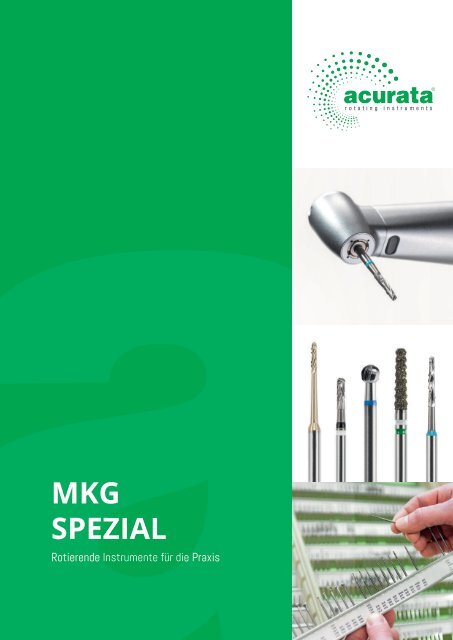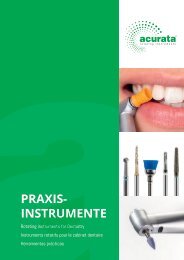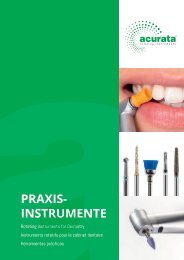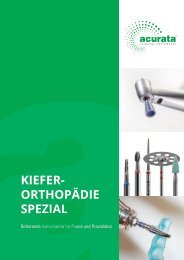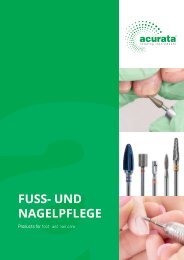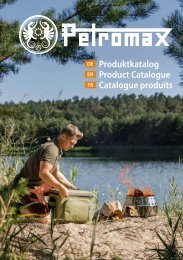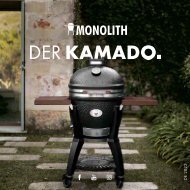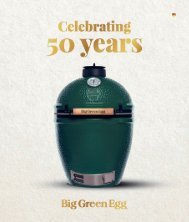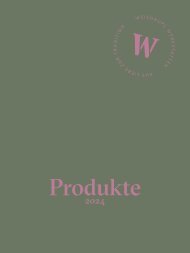MKG Katalog 2022
Erfolgreiche ePaper selbst erstellen
Machen Sie aus Ihren PDF Publikationen ein blätterbares Flipbook mit unserer einzigartigen Google optimierten e-Paper Software.
<strong>MKG</strong><br />
SPEZIAL<br />
Rotierende Instrumente für die Praxis
Allgemine Informationen<br />
2<br />
ALLGEMEIN<br />
Technische Informationen<br />
General technical informations<br />
SCHAFTARTEN<br />
Types of shank<br />
mm<br />
ISO<br />
Ø mm<br />
FG 314 1,6 19,0<br />
FGL 315 1,6 21,0<br />
FGXL 316 1,6 28,0<br />
RA 204 2,35 22,0<br />
RAL 205 2,35 26,0 – 30,0<br />
HP 104 2,35 45,0<br />
HPL 105 2,35 65,0<br />
HPXL 106 2,35 70,0<br />
Die Gesamtlänge der Instrumente kann je nach Arbeitsteil- und Halslänge variieren!<br />
All-over length of instruments may vary depending on length of working part and neck!<br />
ISO Ø = 1/100 mm<br />
Länge Arbeitsteil<br />
Head Length<br />
L = mm<br />
s<br />
ISO 025 = 2,5 mm<br />
Ø mm<br />
SYMBOLE<br />
Symbols<br />
Kieferchirurgie<br />
Ausbohren alter Füllungen<br />
Kronentrennen<br />
Oral surgery<br />
Removal of old fillings<br />
Crown cutting<br />
acurata GmbH & Co. KGaA · Schulstraße 25 · 94169 Thurmansbang<br />
Telefon +49 8504 9117-0 · Fax +49 8504 9117-90 · E-Mail info@acurata.de · www.acurata.de<br />
© <strong>2022</strong> acurata GmbH & Co. KGaA, Thurmansbang · Alle Rechte vorbehalten · All rights reserved · acurata <strong>MKG</strong> <strong>2022</strong>/05
3<br />
ZRN-KNOCHENSÄGEN<br />
ZRN-Knochensägen<br />
ZrN-bone-saw<br />
Zügiges Separieren von Knochensubstanz durch 4-schneidige<br />
Sägeverzahnung, mit Zirkoniumnitrid (ZrN)-Verschleißschutzschicht<br />
• Hohe Korrosionsbeständigkeit und reduzierter Verschleiß<br />
• Leichte Wiederaufbereitung/Reinigung<br />
• Sehr glatte Oberfläche sorgt für gleichbleibende<br />
Schnittfreudigkeit während des Eingriffs<br />
• Reduzierter Verschleiß sorgt für noch mehr Wirtschaftlichkeit<br />
„Saw-toothing“ with 4 blades for fast cutting of bone substance,<br />
ZrN-coating as wear-protection coating<br />
• High corrosion resistance and reduced wear<br />
• Easy reprocessing/ cleaning<br />
• Very smooth surface ensures a constant cutting capacity<br />
during the intervention<br />
• Reduced wear ensures more efficiency<br />
Für den Schnellläufer · For the high-speed handpiece<br />
510 205 408S 297 016 510 205 409S 297 021 510 316 254 297 012 510 316 408S 297 016 510 317 254 297 012<br />
L 10,0 10,0 L 6,0 10,0 6,0<br />
Ø mm 1,6 2,1 Ø mm 1,2 1,6 1,2<br />
Gesamtlänge: 30,0 mm · Total length: 30,0 mm<br />
Gesamtlänge: 28,0 mm · Total length: 28,0 mm<br />
Gesamtlänge: 32,0 mm<br />
Total length: 32,0 mm<br />
”Lindemannfräser“<br />
”Lindemannfräser“<br />
”Lindemannfräser“<br />
”Lindemannfräser“<br />
”Lindemannfräser“<br />
510 104 408S 297 016 510 104 409S 297 021 510 104 254 297 012 510 104 254 297 016<br />
L 10,0 10,0 6,0 6,0<br />
Ø mm 1,6 2,1 1,2 1,6<br />
Gesamtlänge: 45,0 mm · total length: 45,0 mm<br />
FGXL 316 = 28,0 mm FGXXL 317 = 32,0 mm RAL 205 = 26,0 –30,0 mm<br />
HP 104 = 45,0 mm HPL 105 = 65,0 mm HPXL 106 = 70,0 mm RAXL 206 = 34,0 mm
HM-Knochensägen<br />
HM-KNOCHENSÄGEN<br />
4<br />
Bone-saw<br />
Zügiges Separieren von Knochensubstanz durch 4-schneidige Sägeverzahnung<br />
"Saw-toothing" with 4 blades for fast cutting of bone substance<br />
500 316 254 297 012 500 316 408S 297 016 500 317 254 297 012<br />
L 6,0 10,0 6,0<br />
Ø mm 1,2 1,6 1,2<br />
500 205 254 297 012 500 205 254 297 016 500 205 408S 297 016 500 205 409S 297 021<br />
L 6,0 6,0 10,0 10,0<br />
Ø mm 1,2 1,6 1,6 2,1<br />
”Lindemannfräser“<br />
”Lindemannfräser“<br />
”Lindemannfräser“<br />
”Lindemannfräser“<br />
”Lindemannfräser“<br />
”Lindemannfräser“<br />
”Lindemannfräser“<br />
500 104 254 297 012 500 104 254 297 016 500 104 408S 297 016 500 104 409S 297 021 500 106 408S 297 016 500 106 409S 297 021<br />
L 6,0 6,0 10,0 10,0 10,0 10,0<br />
Ø mm 1,2 1,6 1,6 2,1 1,6 2,1<br />
Gesamtlänge: 70,0 mm · total length: 70,0 mm<br />
FGXL 316 = 28,0 mm FGXXL 317 = 32,0 mm RAL 205 = 26,0 –30,0 mm<br />
HP 104 = 45,0 mm HPL 105 = 65,0 mm HPXL 106 = 70,0 mm RAXL 206 = 34,0 mm
acurata<br />
empfiehlt<br />
HARTMETALL-CHIRURGIEFRÄSER<br />
Separieren von Knochenmaterial, Trennen von Zahnwurzel und Zähnen<br />
Chirurgiefräser<br />
5<br />
Surgery TC-Cutter, Separation of bone material, tooth root and teeth<br />
HM-CHIRURGIEFRÄSER 3CUT<br />
• Dreischneidige Verzahnung mit sehr grobem,<br />
sägeförmigen Querhieb und Freischliff<br />
• Spatenförmige Kopfschneide<br />
• Hohe Schnittleistung<br />
• Sehr gute Führbarkeit<br />
• Verbesserte Sicht auf den Arbeitsbereich<br />
• Weniger Flüssigkeitsverwirbelungen<br />
TC-SURGERY TC-CUTTER 3CUT<br />
• Three-edged toothing with very coarse,<br />
saw-shaped cross cut and neck<br />
• Spade-shaped cutting edge<br />
• High cutting performance<br />
• Very good controllability<br />
• Improved visibility on the working area<br />
• Less liquid turbulences<br />
NEU<br />
NEU<br />
500 316 178 338 016 500 104 178 338 016<br />
L 8,0 10,0<br />
Ø mm 1,6 1,6<br />
FGXL 316 = 28,0 mm FGXXL 317 = 32,0 mm RAL 205 = 26,0 –30,0 mm<br />
HP 104 = 45,0 mm HPL 105 = 65,0 mm HPXL 106 = 70,0 mm RAXL 206 = 34,0 mm
HM-Knochensägen<br />
6<br />
HM-KNOCHENSÄGEN<br />
Separieren von Knochenmaterial, Trennen von Zahnwurzel und Zähnen<br />
Separation of bone material, tooth root and teeth<br />
• Verlängertes Arbeitsteil für eine breite Schnittfläche<br />
• Arbeitsteil zur Spitze hin konisch verjüngt, für ein besonders<br />
filigranes Eindringverhalten in das Knochenmaterial<br />
• Lengthened working part for a wider cutting surface<br />
• Working part conically tapered to the tip, for a particularly<br />
filigree penetration characteristics in the bone material<br />
500 104 254L 297 014 500 205 254L 297 014 500 316 254L 297 014 500 317 254L 297 014<br />
L 8,0 8,0 8,0 8,0<br />
Ø mm 1,4 1,4 1,4 1,4<br />
• Ermöglicht sehr präzises Arbeiten an schwer erreichbaren<br />
Stellen<br />
• Für minimalinvasives Arbeiten mit kleinstmöglichem<br />
Substanzverlust, filigranes Arbeitsteil, konisch verjüngt<br />
• Enables a very precise working on hard to reach places<br />
• For a minimally invasive work with the smalles possible<br />
loss of material, filigree working part, conically tapered<br />
• Höchste Laufruhe durch chirurgische Kreuzverzahnung<br />
• Arbeitsteil zur Spitze hin parallel verlaufend,<br />
für eine gleichmäßige axiale Präparation ohne Verkanten<br />
• Reduzierter Verschleiß sorgt für noch mehr Wirtschaftlichkeit<br />
• Very smooth running due to surgical cross cut<br />
• Working part parallel to the tip, for an uniform axial<br />
preparation without twisting<br />
• Reduced wear for more efficiency<br />
500 315 254L 298 012<br />
L 7,0<br />
Ø mm 1,2<br />
500 104 255 298 012 500 205 255 298 012 500 316 255 298 012<br />
L 6,0 6,0 6,0<br />
Ø mm 1,2 1,2 1,2<br />
FGXL 316 = 28,0 mm FGXXL 317 = 32,0 mm RAL 205 = 26,0 –30,0 mm<br />
HP 104 = 45,0 mm HPL 105 = 65,0 mm HPXL 106 = 70,0 mm RAXL 206 = 34,0 mm
SPEZIAL-KNOCHENSÄGEN<br />
7<br />
Spezial-Knochensägen<br />
bone saw – special types<br />
295 CHIRURGISCHE EINFACHVERZAHNUNG<br />
Surgical simple toothing<br />
506 104 199 295 016T 506 104 408 295 016T 506 205 408 295 016T 506 316 199 295 016T 506 316 408 295 016T<br />
Ø mm / L 1,6 / 9,2<br />
297 CHIRURGISCHE SPIRALVERZAHNUNG MIT QUERHIEB<br />
Surgical spiral toothing with cross cut<br />
506 104 408 297 016T 506 104 409 297 021T 506 205 408 297 016T 506 205 409 297 021T 506 316 408 297 016T<br />
Ø mm / L 1,6 / 9,2 2,1 / 9,2 1,6 / 9,2 2,1 / 9,2 1,6 / 9,2<br />
298 CHIRURGISCHE KREUZVERZAHNUNG<br />
Surgical cross cut toothing<br />
506 104 408 298 016T 506 104 409 298 021T 506 205 408 298 016T 506 205 409 298 021T 506 206 408 298 016T 506 206 409 298 021T 506 316 408 298 016T<br />
Ø mm / L 1,6 / 9,2 2,1 / 9,2 1,6 / 9,2 2,1 / 9,2 1,6 / 9,2 2,1 / 9,2 1,6 / 9,2<br />
FGXL 316 = 28,0 mm FGXXL 317 = 32,0 mm RAL 205 = 26,0 –30,0 mm<br />
HP 104 = 45,0 mm HPL 105 = 65,0 mm HPXL 106 = 70,0 mm RAXL 206 = 34,0 mm
8<br />
ZrN-Kugelfräser<br />
ZRN-KUGELFRÄSER<br />
ZrN-ball cutter<br />
Chirurgische Kreuzverzahnung, besonders laufruhig, zügiges Separieren<br />
von Knochen- und Zahnhartsubstanz, mit Zirkoniumnitrid<br />
(ZrN)-Verschleißschutzschicht<br />
Surgical cross-cut, particularly smooth-running, fast cutting of bone<br />
substance and tooth structure, with zirconium nitride (ZrN) wear<br />
protection coating<br />
510 104 001 258 018 510 104 001 258 021 510 104 001 258 023 510 104 001 258 027 510 104 001 258 031 510 104 001 258 035 510 104 001 258 040<br />
L 1,8 2,1 2,3 2,7 3,1 3,5 4,0<br />
Ø mm 1,8 2,1 2,3 2,7 3,1 3,5 4,0<br />
RAL = 26,0 mm<br />
510 205 001 258 018 510 205 001 258 021 510 205 001 258 023 510 205 001 258 027 510 205 001 258 031 510 205 001 258 035 510 205 001 258 040<br />
L 1,8 2,1 2,3 2,7 3,1 3,5 4,0<br />
Ø mm 1,8 2,1 2,3 2,7 3,1 3,5 4,0<br />
FGXL 316 = 28,0 mm FGXXL 317 = 32,0 mm RAL 205 = 26,0 –30,0 mm<br />
HP 104 = 45,0 mm HPL 105 = 65,0 mm HPXL 106 = 70,0 mm RAXL 206 = 34,0 mm
9<br />
KUGELFRÄSER<br />
Kugelfräser<br />
ball cutter<br />
Feine chirurgische Kreuzverzahnung, besonders laufruhig<br />
Fine surgical cross-cut, particularly smooth-running<br />
500 104 001 258 018 500 104 001 258 021 500 104 001 258 023 500 104 001 258 027 500 104 001 258 031 500 104 001 258 035 500 104 001 258 040<br />
L 1,8 2,1 2,3 2,7 3,1 3,5 4,0<br />
Ø mm 1,8 2,1 2,3 2,7 3,1 3,5 4,0<br />
HPL = 65,0 mm<br />
500 105 001 258 023 500 105 001 258 027 500 105 001 258 031 500 105 001 258 035 500 105 001 258 040<br />
L 2,3 2,7 3,1 3,5 4,0<br />
Ø mm 2,3 2,7 3,1 3,5 4,0<br />
FGXL 316 = 28,0 mm FGXXL 317 = 32,0 mm RAL 205 = 26,0 –30,0 mm<br />
HP 104 = 45,0 mm HPL 105 = 65,0 mm HPXL 106 = 70,0 mm RAXL 206 = 34,0 mm
Kugelfräser<br />
KUGELFRÄSER<br />
10<br />
ball cutter<br />
Feiner 10-schneidiger Kugelfräser, besonders laufruhig<br />
Fine 10-blade ball cutter, especially smooth-running<br />
500 205 001 251 027 500 205 001 251 031 500 205 001 251 035 500 205 001 251 040<br />
L 2,7 3,1 3,5 4,0<br />
Ø mm 2,7 3,1 3,5 4,0<br />
500 104 001 251 027 500 104 001 251 031 500 104 001 251 035 500 104 001 251 040<br />
L 2,7 3,1 3,5 4,0<br />
Ø mm 2,7 3,1 3,5 4,0<br />
Diamant-Chirurgiefräser<br />
Diamond surgery cutter<br />
806 104 242 524 023 806 104 242 524 027 806 104 242 524 031 806 104 242 524 035 806 104 242 524 040 806 104 242 524 050<br />
L 2,3 2,7 3,1 3,5 4,0 5,0<br />
Ø mm 2,3 2,7 3,1 3,5 4,0 5,0<br />
FGXL 316 = 28,0 mm FGXXL 317 = 32,0 mm RAL 205 = 26,0 –30,0 mm<br />
HP 104 = 45,0 mm HPL 105 = 65,0 mm HPXL 106 = 70,0 mm RAXL 206 = 34,0 mm
KUGELFRÄSER<br />
11<br />
Kugelfräser<br />
ball cutter<br />
291<br />
CHIRURGISCHE SPIRALVERZAHNUNG<br />
Surgical spiral toothing<br />
506 104 001 291 010T 506 104 001 291 014T 506 104 001 291 018T 506 104 001 291 023T 506 104 001 291 027T 506 104 001 291 031T<br />
Ø mm / L 1,0 / 1,0 1,4 / 1,4 1,8 / 1,8 2,3 / 2,3 2,7 / 2,7 3,1 / 3,1<br />
506 104 001 291 035T 506 104 001 291 040T 506 104 001 291 050T 506 205 001 291 010T 506 205 001 291 014T 506 205 001 291 018T<br />
Ø mm / L 3,5 / 3,5 4,0 / 4,0 5,0 / 5,0 1,0 / 1,0 1,4 / 1,4 1,8 / 1,8<br />
506 205 001 291 023T 506 205 001 291 027T 506 205 001 291 031T 506 205 001 291 035T 506 205 001 291 040T 506 205 001 291 050T<br />
Ø mm / L 2,3 / 2,3 2,7 / 2,7 3,1 / 3,1 3,5 / 3,5 4,0 / 4,0 5,0 / 5,0<br />
FGXL 316 = 28,0 mm FGXXL 317 = 32,0 mm RAL 205 = 26,0 –30,0 mm<br />
HP 104 = 45,0 mm HPL 105 = 65,0 mm HPXL 106 = 70,0 mm RAXL 206 = 34,0 mm
Kugelfräser<br />
KUGELFRÄSER<br />
12<br />
ball cutter<br />
298<br />
CHIRURGISCHE KREUZVERZAHNUNG<br />
Surgical cross cut toothing<br />
506 104 001 298 023T 506 104 001 298 027T 506 104 001 298 031T 506 104 001 298 035T 506 104 001 298 040T<br />
Ø mm / L 2,3 / 2,3 2,7 / 2,7 3,1 / 3,1 3,5 / 3,5 4,0 / 4,0<br />
506 205 001 298 023T 506 205 001 298 027T 506 205 001 298 031T 506 205 001 298 035T 506 205 001 298 040T<br />
Ø mm / L 2,3 / 2,3 2,7 / 2,7 3,1 / 3,1 3,5 / 3,5 4,0 / 4,0<br />
506 206 001 298 023T 506 206 001 298 027T 506 206 001 298 031T 506 206 001 298 035T<br />
Ø mm / L 2,3 / 2,3 2,7 / 2,7 3,1 / 3,1 3,5 / 3,5<br />
FGXL 316 = 28,0 mm FGXXL 317 = 32,0 mm RAL 205 = 26,0 –30,0 mm<br />
HP 104 = 45,0 mm HPL 105 = 65,0 mm HPXL 106 = 70,0 mm RAXL 206 = 34,0 mm
PILOTBOHRER<br />
Pilotbohrer<br />
13<br />
Pilot drill<br />
• Rostfreier Edelstahl mit geringer Bruchneigung<br />
• Schnittfreudige 2-Schneiden-Konstruktion<br />
mit großen Spannuten für eine leichte Spanabfuhr<br />
• S-förmige Schneidenspitze für leichtes Eindringen<br />
• Hinterschliffene Spannuten für geringe Reibung am Knochen<br />
• Laser-Tiefenmarkierungen für tiefengenaues Bohren<br />
(nach je 2,0 mm), 2-Schneider ab 8,0 mm,<br />
3-Schneider ab 6,0 mm Bohrtiefe<br />
• Stainless special steel with a low cracking tendency<br />
• Sharp 2-blades-construction with big flutes<br />
for an easy chip removal<br />
• S-shaped blade tip for easy penetrating<br />
• Relief-ground flutes for a low friction on the bone<br />
• Laser-depth marking for accurate drilling<br />
(after each 2,0 mm),<br />
• 2-blades after 8,0 mm, 3-blades after 6,0 mm drilling depth<br />
330 204 P210 L16 015 330 204 P210 L16 018 330 204 P210 L16 020<br />
L 16,0 16,0 16,0<br />
Ø mm 1,5 1,8 2,0<br />
2-Schneider · 2 Blades<br />
330 204 P210 L16 022 330 204 P210 L16 025 330 204 P210 L16 028<br />
L 16,0 16,0 16,0<br />
Ø mm 2,2 2,5 2,8<br />
2-Schneider · 2 Blades<br />
Optimale Drehzahl: 800 min -1 – 1.200 min -1 bei max. 2N Anpresskraft.<br />
Immer mit 50 ml/min., Kühlspray anwenden.<br />
Optimum speed: 800 min -1 – 1.200 min -1 . Do not exceed the maximum of 2N.<br />
Always use with spray, 50 ml/min.
Pilotbohrer<br />
PILOTBOHRER<br />
14<br />
Pilot drill<br />
330 204 P210 L20 015 330 204 P210 L20 018 330 204 P210 L20 020 330 204 P210 L20 022 330 204 P210 L20 025 330 204 P210 L20 028<br />
L 20,0 20,0 20,0 20,0 20,0 20,0<br />
Ø mm 1,5 1,8 2,0 2,2 2,5 2,8<br />
2-Schneider · 2 Blades<br />
INITIALBOHRER<br />
Initial bur<br />
330 204 P310 L16 035 330 204 P310 L20 028 330 204 P310 L20 035<br />
L 16,0 20,0 20,0<br />
Ø mm 3,5 2,8 3,5<br />
330 204 684 377 018<br />
L 12,0<br />
Ø mm 1,8<br />
3-Schneider · 3 Blades · 3-lames · 3 cuchillas<br />
Optimale Drehzahl: 800 min -1 – 1.200 min -1 bei max. 2N Anpresskraft.<br />
Immer mit 50 ml/min., Kühlspray anwenden.<br />
Optimum speed: 800 min -1 – 1.200 min -1 . Do not exceed the maximum of 2N.<br />
Always use with spray, 50 ml/min.
PERIIMPLANTITIS-FINIERER<br />
Extralang, Gesamtlänge 30,0 mm<br />
Periimplantatis-Finierer<br />
15<br />
peri-implantitis burs, extra long, total length 30,0 mm<br />
Die acurata Perimplantitis-Finierer sind hervorragend zum Glätten<br />
der Implantatoberflächen geeignet und unterstützen das Bemühen<br />
das Implantat zu erhalten.<br />
The acurata peri-implantitis finishers are outstandingly<br />
suitable to smooth the implant surfaces and support the effort<br />
to preserve the implant.<br />
EXTRAFEIN Extra fine<br />
500 317 249 032 014 500 317 249 032 023 500 317 277 032 014 500 317 277 032 023<br />
L 8,0 8,0 5,0 5,0<br />
Ø mm 1,4 2,3 1,4 2,3<br />
FEIN Fine<br />
500 317 249 072 014 500 317 249 072 023 500 317 277 072 014 500 317 277 072 023<br />
L 8,0 8,0 5,0 5,0<br />
Ø mm 1,4 2,3 1,4 2,3
Trepan-Bohrer<br />
TREPAN-BOHRER<br />
16<br />
Trepan bur<br />
• Ihre Handlichkeit und geringe Bohrtiefe<br />
ermöglichen eine optimale Sicht auf das Arbeitsfeld<br />
und reduzieren somit die Verletzungsgefahr<br />
• Diese Instrumente sind aus rostfreiem, gehärteten Stahl,<br />
für eine leichte Identifizierung sind der Außenund<br />
Innendurchmesser am Instrumentenschaft aufgelasert<br />
• Einfaches Ausstoßen der Knochenzylinder<br />
durch die eingefrästen Fenster am Instrument<br />
• Their handiness and low drilling depth allow<br />
an optimal visibility on the work surface and reduce<br />
consequently the risk of injury<br />
• These instruments are made of hardened stainless steel,<br />
for an easy identifying, the external and internal diameters<br />
are lasered on the shank<br />
• Easy grinding of the bone cylinders by the milled down<br />
windows on the instrument<br />
L=Bohrtiefe<br />
L=Drilling depth<br />
Ø mm=Außen/Innen<br />
Ø mm=Out/In<br />
• Zur Entnahme von Knochendeckeln bei Wurzelspitzenresektion.<br />
• Durch die maximale Bohrtiefe von 5,0 mm<br />
und die reduzierte Gesamtlänge eignen sich diese Instrumente<br />
auch für den Seitenzahnbereich (Prämolaren/Molaren)<br />
• For removal of the bone cover during the root tip resection.<br />
• By the maximum drilling depth of 5.0 mm and the reduced<br />
total length, those instruments are also suitable<br />
for the posterior region (premolars/molars)<br />
330 204 227 040 330 204 227 050 330 204 227 060 330 204 227 070<br />
L 5,0 5,0 5,0 5,0<br />
Ø mm 4,0 / 2,9 5,0 / 3,9 6,0 / 4,9 7,0 / 5,9
TREPAN-BOHRER<br />
17<br />
Trepan-Bohrer<br />
Trepan bur<br />
• Zur Präparation von Knochenzylindern zur Knochengewinnung<br />
• Maximale Bohrtiefe von 8,0 mm<br />
• For the preparation of bone cylinders for bone harvesting<br />
• Maximum drilling depth of 8 mm<br />
330 204 228 040 330 204 228 050 330 204 228 060 330 204 228 070<br />
L 8,0 8,0 8,0 8,0<br />
Ø mm 4,0 / 2,9 5,0 / 3,9 6,0 / 4,9 7,0 / 5,9<br />
• Zum Explantieren, maximale Bohrtiefe von 18,0 mm<br />
• Implantate bis zu einem Durchmesser von 4,8 mm<br />
und einer maximalen Gesamtlänge von 18,0 mm<br />
• Aufgelaserte Tiefenmarkierungen ermöglichen tiefengenaues Arbeiten<br />
• Eingefräste Fenster ermöglichen eine gute Sicht<br />
und unterstützen die Kühlung für eine atraumatische Explantation<br />
• Rostfreier, gehärteten Stahl<br />
• Außen- und Innendurchmesser am Instrumentenschaft aufgelasert<br />
• For explantation, maximum drilling depth of 18,0 mm<br />
• Implants up to a diameter of 4,8 mm and a maximum<br />
total length of 18,0 mm<br />
• Laser marked depth markings allow precise working<br />
• Cut in windows enable a clear visibility and facilitate the cooling<br />
for an atraumatic explantation<br />
• Stainless, hardened steel<br />
• Outside and inside diameter laser marked on the instrument shank<br />
330 204 229 035 330 204 229 050 330 204 229 060<br />
L 18,0 18,0 18,0<br />
Ø mm 3,5 / 2,9 5,0 / 3,9 6,0 / 4,9<br />
Anwendungshinweise für Trepan-Bohrer: Der Einsatz erfolgt im untersetzten<br />
Winkelstück (Mindestuntersetzung 10 : 1), unter permanenter, steriler Außenkühlung.<br />
Drehzahl opt.: 800 – 1.000 min -1 Drehzahl max.: 5.000 – 6.000 min-1<br />
Recommendations for Trepan bur: To use with contra-angle handpiece<br />
(minimum speed reduction 10 : 1) and permanent, sterile cooling. Optimum<br />
Speed: 800 – 1.000 min -1 Max. Speed: 5.000 – 6.000 min -1
Kronentrenner<br />
18<br />
KRONENTRENNER<br />
acurata<br />
empfiehlt<br />
Crown cutter<br />
KRONENTRENNER MK / RR FÜR NEM-KRONEN, REDUZIERTE LEGIERUNGEN UND EM<br />
Crown cutter MK / RR for non-precious alloys, reduced alloys and precious metals<br />
• Innovative Schneidengeometrie<br />
• Schneidet selbst härteste Legierungen schnell und zügig<br />
• Präziser Rundlauf<br />
• Innovative cutting edge geometries<br />
• Cuts even hardest alloys quickly and efficiently<br />
• High concentricity<br />
500 314 140 MK 014 500 314 139 RR 012 500 314 140 RR 012 500 314 140 RR 014 500 314 195 RR 012<br />
L 5,0 4,0 5,0 5,0 4,0<br />
Ø mm 1,4 1,2 1,2 1,4 1,2<br />
MULTIFUNKTIONSTRENNER SCC FÜR METALLKRONEN UND AMALGAMFÜLLUNGEN<br />
Multifunctional separator SCC for metal crowns and amalgam fillings<br />
• Schnelles und wirtschaftliches Trennen<br />
• Spiralverzahnung mit feinem Querhieb<br />
• 8 Schneiden mit dominanter Kopfschneide<br />
• Fast and efficient separation<br />
• Spiral toothing with fine cross cut<br />
• 8 cutting edges with dominant head cutting edge<br />
500 314 137 SCC 010 500 314 139 SCC 012 500 314 140 SCC 012 500 314 140 SCC 014 500 314 140 SCC 016<br />
L 2,0 4,0 5,0 5,0 5,0<br />
Ø mm 1,0 1,2 1,2 1,4 1,6
534<br />
Grob · Coarse · Gros · Grueso<br />
KRONENTRENNER<br />
19<br />
Kronentrenner<br />
Crown cutter<br />
LARRY BLACK<br />
acurata<br />
empfiehlt<br />
Unser Spezialist für Hochleistungskeramiken wie Zirkonoxid<br />
oder Lithiumdisilikat. Tipp: Tangentiale Arbeitsweise und leichte<br />
„Sägebewegung“ erleichtert das Auftrennen der Keramik.<br />
• Trennt alle Keramikwerkstoffe leicht und zügig<br />
• Konisches, verlängertes Arbeitsteil<br />
• Unterbrochener Schnitt sorgt für zügigen Abtrag<br />
• Verbesserte Kühlmöglichkeit dank Wellenprofil<br />
• Mehr Diamantkörner durch vergrößerte Oberfläche<br />
• Hochleistungsdiamantbelag für max. Haltbarkeit<br />
Our specialist for high-performance ceramics like zircon<br />
oxide or lithium disilicate. Tip: tangential workings and slight<br />
sawing movement facilitates the separation of ceramic.<br />
• Separates all ceramic materials, easily and quickly<br />
• Conical, extended working part<br />
• Interrupted cut provides a quick removal<br />
• Improved cooling capability due to a corrugated profile<br />
• More diamnd grains by an enlarged surface<br />
• High performance diamond coating for max. durability<br />
800 314 473 528 016<br />
L 8,0<br />
Ø mm 1,6
524 524<br />
Mittel · Medium<br />
544<br />
Supergrob · Super coarse<br />
Kronentrenner<br />
KRONENTRENNER<br />
20<br />
DIAMANT FÜR VOLLKERAMIKKRONEN AUS ZRO<br />
Diamond for all-ceramic crowns made of ZrO<br />
• Ruhiger, kontrollierter Lauf<br />
• Langlebiger Hochleistungsdiamantbelag<br />
• Smooth, controlled running<br />
• Long lasting high performance diamond coating<br />
• Schlankes, verlängertes Arbeitsteil<br />
für flächiges Nacharbeiten<br />
806 314 140 526 012<br />
L 6,5<br />
• Slender, extended working part<br />
for extensive finishing<br />
Ø mm 1,2<br />
• Konisches, sehr robustes Arbeitsteil<br />
für Trennschnitte<br />
806 314 194 526 016<br />
L 4,5<br />
• Conical, very strong working<br />
part for separation cuts<br />
Ø mm 1,6<br />
DIAMANT FÜR VERBLENDKERAMIK<br />
Diamond for ceramic veneering<br />
• Schlankes Arbeitsteil<br />
• Hohe Schnittleistung „supergrob“<br />
806 314 139 544 012<br />
L 5,5<br />
• Slender working part<br />
• High cutting performance “super coarse”<br />
Ø mm 1,2
ev. 07/15<br />
ANWENDUNGS- UND SICHERHEITSHINWEISE<br />
General Information for Use and Safety<br />
Anwendungshinweise<br />
21<br />
acurata GmbH & Co. KGaA Instrumente sind für den dental medizinischen Bereich bestimmt und dürfen nur von Zahnärzten bzw. entsprechend qualifizierten Experten eingesetzt werden, die<br />
aufgrund ihrer Ausbildung und ihrer Erfahrung mit der Anwendung der Produkte vertraut sind. Instrumente werden unsteril ausgeliefert und sind vor jeder Anwendung aufzubereiten.<br />
ALLGEMEINE ANWENDUNGSHINWEISE<br />
Nur technisch und hygienisch einwandfreie Antriebe mit stabiler Kugellagerung verwenden! Instrumente sorgfältig, so tief wie möglich, einspannen und vor dem Ansetzen auf Drehzahl bringen.<br />
Maximal zulässige Drehzahlen Angabe auf den Verpackungs-Etiketten beachten. Hebeln und Verkanten vermeiden, sonst Bruchgefahr. Auf ausreichende Kühlung (50 ml/min.) achten, sonst<br />
besteht die Gefahr durch thermische Schädigung. Bei FG-Instrumenten mit einer Gesamtlänge > 19 mm und bei Instrumenten mit einem Arbeitsteildurchmesser > 2 mm (ISO 020) zusätzlich<br />
kühlen. Stumpfe, verbogene oder beschädigte Instrumente sofort aussortieren und nicht mehr verwenden. Unsachgemäße Anwendung führt zu erhöhtem Risiko, größerem Verschleiß und<br />
schlechteren Arbeitsergebnissen!<br />
Anpresskräfte: Die Anpresskräfte sollen gering sein, maximal 2N nicht überschreiten. Überhöhte Anpresskräfte können zu Beschädigungen der Instrumente führen. Im Extremfall kann das<br />
Instrument brechen! Gleichzeitig entsteht eine größere Wärmeentwicklung. Durch Überhitzung kann die Pulpa geschädigt werden, die Instrumente verschleißen schneller und die Oberflächen<br />
werden rauer.<br />
Hinweise: Polierer und Instrumente mit langen Arbeitsteilen bzw. langen, dünnen Hälsen (z.B. micro Präparationsinstrumente), oder besonderen Einsatzgebieten (z. B. Kronentrenner, lange Chirurgiefräser),<br />
neigen bei Überschreitung der maximal zulässigen Drehzahlen zu Resonanzschwingungen (Vibrieren), oder Auslenkungen (Schlagen), was zum Bruch oder starker Beschädigung<br />
führen kann. Nichtbeachtung führt zu einem erhöhten Sicherheitsrisiko · Die jeweilige maximale Drehzahl ist ein theoretischer Wert, der basierend auf der Geometrie der Instrumente angegeben<br />
wird. Die Auswahl der Arbeitsdrehzahl richtet sich nach dem zu bearbeitenden Material, der Indikation, dem Antrieb und den Anpresskräften und liegt im Ermessen des Anwenders.<br />
Bitte beachten Sie eine trockene, staub- und sonnengeschützte Lagerung bei angemessener Raumtemperatur.<br />
Maximale Drehzahlen – Richtwerttabelle<br />
FG-Instrumente (ISO 314) ISO Ø: 005 – 016 max. 450.000 min -1 • 018 – 021 max. 300.000 min -1 • 023 – 031 max. 160.000 min -1 • 033 – 055 max. 120.000 min -1<br />
Hand- und Winkelstückinstrumente (ISO 104 / 204) ISO Ø: 003 – 023 max. 50.000 min -1 • 025 – 040 max. 40.000 min -1 • 045 – 060 max. 30.000 min -1 • 060 – 070 max. 25.000 min -1 • 070 – 250 max. 25.000 min -1 •<br />
300 – 380 max. 20.000 min -1 • 450 max. 15.000 min -1<br />
Polier-Instrumente alle ISO Ø: max. 5.000 –10.000 min -1<br />
Es gelten die Angaben auf dem Etikett der Verpackung. Optimale Drehzahl für alle Instrumente, je nach zu bearbeitenden Material, ist in der Regel 40 bis 50% der Maximalangabe!<br />
ANWENDUNGSHINWEISE FÜR ENDODONTISCHE INSTRUMENTE<br />
K-Reamer: Stoßend / drehende Bewegung im Uhrzeigersinn max. 90°, K-Feile: Feilende Bewegung bis max. 45° im Uhrzeigersinn. Hedstroem: Stoß- und Zugbewegung mit oder ohne Drehung<br />
bis max. 90° · In aufsteigender Größe einsetzen (keine Größe überspringen) · Nickel-Titanium Instrumente eignen sich wegen ihrer großen Elastizität und Rückstelleigenschaften · besonders<br />
für stark gekrümmte Wurzelkanäle. Vorbiegen der Feile nicht notwendig · Instrumente vor Aspiration sichern (Kofferdam - Sicherheitskettchen - Fadensicherung) · Silikonstopper sind vor der<br />
Aufbereitung von den Wurzelkanalinstrumenten zu entfernen · Gründliche Reinigung ist Voraussetzung für eine effektive Sterilisation · Sterilisation im Autoclaven kann bei Stahlinstrumenten zu<br />
Korrosion führen · Verbogene, geknickte oder beschädigte Instrumente sofort aussortieren.<br />
Reinigung, Desinfektion, Sterilisation und Lagerung von Medizinprodukten siehe hierzu unsere Hygiene-Empfehlung, auch auf unserer Homepage:<br />
https://www.acurata.de/downloads/hygiene-empfehlungen/.<br />
acurata GmbH & Co. KGaA instruments are intended for the dental medical field and must only be used by dentists or respective experts who, due their training and experience, are familiar with<br />
the use of the products. The instruments are supplied non-sterile and have to be prepared prior to first use (refer to Recommended Hygiene Procedures http://www.acurata.de/en/service/recommended-hygiene-procedures).<br />
INFORMATION FOR USE FOR DENTAL ROTARY INSTRUMENTS<br />
Use only technical and hygienic correct drives with a stable ball bearing! Carefully clamp the instruments as deep as possible and assure that the desired speed is reached prior to usage. Please<br />
note the maximum allowed engine speed as stated on the packaging label. Avoid levering or canting, otherwise there is risk of fracture. Pay attention that there is sufficient cooling (50 ml/min)<br />
otherwise there is risk of thermal damage. FG-instruments with a total length > 19 mm and instruments with a diameter of the work element > 2 mm (ISO 020) need extra cooling. Separate blunt,<br />
twisted or damaged instruments immediately and do not use them again. Improper usage increases risk, higher wear and inferior work results!<br />
Contact pressures: The contact pressures should be light, do not exceed the maximum of 2N. Excessive contact pressures can cause damage to the instruments. In extreme cases the instrument<br />
can fracture! At the same time a higher heat development is generated. Overheating may harm the dental pulp, instruments wear faster and surfaces get coarser.<br />
Remarks: Polishers and instruments with long working part and respectively long, slender necks (e.g. instruments for micro preparation) or for specific application areas (e.g. crown separator,<br />
long chirurgical cutter): exceeding the maximum allowed speeds can cause oscillations (vibrating) or displacement (whippings). This can result in fracture or heavy damage. Non observance<br />
causes an increased security risk! Therefore pay attention to the maximum speed printed on the packaging labels · The respective maximum speed is a theoretical value given on the basis of the<br />
geometry of the instruments. The choice of the working speed is determined by the material subsequently to be used, the specific indication, the type of handpiece used and the contact pressures<br />
and is at user’s discretion. Please ensure a dry, dust-free and sun-protected storage at appropriate room temperature.<br />
Maximum speeds – table of reference values<br />
FG instruments (ISO 314) ISO Ø: 005 – 016 max. 450.000 min -1 • 018 – 021 max. 300.000 min -1 • 023 – 031 max. 160.000 min -1 • 033 – 055 max. 120.000 min -1<br />
HP and RA instruments (ISO 104 / 204) ISO Ø: 003 – 023 max. 50.000 min -1 • 025 – 040 max. 40.000 min -1 • 045 – 060 max. 30.000 min -1 • 060 – 070 max. 25.000 min -1 • 070 – 250 max. 25.000 min -1 • 300 – 380 max.<br />
20.000 min -1 • 450 max. 15.000 min -1<br />
Polishing instruments all ISO Ø: max. 5.000 –10.000 min -1<br />
The information on the label on the packaging applies. Optimum speeds for all instruments depend on the material to be processed. As a general rule 40 – 50% of the maximum<br />
instruction is recommended!<br />
RECOMMENDATIONS FOR USE FOR ROOT CANAL INSTRUMENTS<br />
K-Reamer: push and rotary motion clockwise up to max. 90°. K-File: filing motion clockwise up to max. 45°, Hedstroem: push and pull (with or without rotary) motion up to max. 90°, Usage in<br />
ascending order of size (do not skip any size), High flexible Nickel-Titanium instruments are especially for heavy curved root canals. The file has not to be bent before use, Protect the instruments<br />
against aspiration (rubber dam – safety chain – safety cord), Silicone stoppers have to be removed prior to reprocessing root canal instruments, Clean the instruments properly before sterilization,<br />
Sterilization in autoclave may corrode steel instruments, Do not use bent or damaged instruments.<br />
Cleaning, disinfection, sterilization and storage of medical products – refer to our Recommended Hygiene Procedures, also available on our website:<br />
https://www.acurata.de/en-US/downloads/hygiene-recommendations/
Hygieneempfehlung<br />
22<br />
HYGIENE-EMPFEHLUNG<br />
rev. 07/15<br />
Herstellerinformation zur Wiederaufbereitung gemäß RKI-Richtlinie „Infektionsprävention in der Zahnheilkunde Anforderungen an die Hygiene“ und der KRINKO-Empfehlung „Anforderungen an<br />
die Hygiene bei der Aufbereitung von Medizinprodukten“ für Medizinprodukte Semikritisch B und Kritisch B nach DIN EN ISO 17664.<br />
Hersteller: acurata GmbH & Co. KGaA · Schulstraße 25 · 94169 Thurmansbang · Tel.: +49 8504 9117-0 · Fax.: +49 8504 9117-90 · info@acurata.de · www.acurata.de<br />
Produkte: Diese Herstellerinformation gilt für alle von acurata GmbH & Co. KGaA gelieferten Instrumente, die für chirurgische, parodontologische oder endodontische Maßnahmen eingesetzt<br />
werden. Dies sind rotierende Hartmetall-, Diamant- und Polierinstrumente wie auch oszillierende Instrumente aus rostfreiem Edelstahl oder Nickel-Titan. Das Produktsortiment umfasst ausschließlich<br />
unsteril gelieferte Instrumente, diese sind vor dem erstmaligen (beginnend mit Schritt 2) und jedem weiteren Gebrauch (beginnend mit Schritt 1) aufzubereiten.<br />
Begrenzung der Wiederaufbereitung: Das Ende der Produktlebensdauer wird grundsätzlich von Verschleiß und Beschädigung durch den Gebrauch bestimmt. Häufiges Wiederaufbereiten hat<br />
keine leistungsbeeinflussenden Auswirkungen auf diese Instrumente. Einmalprodukte (Kennzeichnung mit auf dem Etikett) dürfen nicht wiederverwendet werden und keiner Wiederaufbereitung<br />
zugeführt werden.<br />
Grundsätzliche Anmerkung: Beachten Sie die in Ihrem Land gültigen, rechtlichen Bestimmungen zur Wiederaufbereitung von Medizinprodukten (z.B. www.rki.de). Seitens des Herstellers ist<br />
sichergestellt, dass die angeführten, validierten Aufbereitungsverfahren für die Aufbereitung der genannten Instrumentengruppen zu deren Wiederverwendung gemäß Zweckbestimmung geeignet<br />
sind. Der Betreiber ist dafür verantwortlich, dass die tatsächlich durchgeführte Wiederaufbereitung, basierend auf seiner Risikobewertung, mit verwendeter Ausstattung, Materialien, Prozess-Parametern<br />
und Personal, die vorgegebenen Ziele für die vorhergesehene Anwendung erreicht. Dafür sind i.d.R. routinemäßige Kontrollen der validierten maschinellen bzw. der standardisierten<br />
manuellen Aufbereitungsverfahren erforderlich. Ebenso sollte jede Abweichung von den validierten Verfahren sorgfältig durch den Aufbereiter auf ihre Wirksamkeit und mögliche nachteilige<br />
Folgen ausgewertet und freigeben werden. Die Hygiene-Empfehlung ist auf unsere Homepage jederzeit aktuell verfügbar: www.acurata.de/downloads/hygiene-empfehlungen<br />
1<br />
Vorbereitung inkl. Aufbewahrung und Transport<br />
Bei erstmaligem Gebrauch mit Schritt 2 beginnen. Instrumentarium möglichst unmittelbar, spätestens 1 Stunde nach der Anwendung am Patienten, in einen mit geeignetem Reinigungs- / Desinfektionsmittel (nicht<br />
fixierend/aldehydfrei z.B. BIB forte eco) befüllten Fräsator geben. Bohrerbad wird in einer Konzentration gemäß Angaben des Herstellers hergestellt; bei z.B. BIB forte eco das Konzentrat mit Wasser ansetzen, erst<br />
Wasser dann Konzentrat hinzugeben. Fräsator abdecken. Einwirkzeit beachten (z.B. BIB forte eco 0,5% 60 min.). Der Transport der Instrumente zum Aufbereitungsort sollte kontaminationsgeschützt im Fräsator<br />
erfolgen.<br />
2 Reinigung und Desinfektion<br />
Gemäß Empfehlung des Robert Koch Institutes (RKI) und der Kommission für Krankenhaushygiene u. Infektionsprävention (KRINKO) sollte die Aufbereitung von Semikritisch-B-Produkten bevorzugt maschinell<br />
erfolgen; Kritisch-B-Produkte sollen grundsätzlich maschinell aufbereitet werden. Bei Produkten mit langen, engen Lumina oder Hohlräumen muss die Reinigung maschinell erfolgen. Bei Wurzelkanalinstrumenten<br />
sind Silikonstopper vor der Aufbereitung zu entfernen.<br />
Maschinelle Reinigung – validiertes Verfahren<br />
Ausstattung: Reinigungsbürste, Reinigungs-/Desinfektionsgerät (RDG) Miele mit Vario TD<br />
Programm, gemäß EN ISO 15883,Reinigungsmittel 0,5% Reiniger Neodisher mediclean, acurata<br />
Instrumentenständer aus Edelstahl.<br />
Verfahren: Instrumentarium unmittelbar vor der maschinellen Aufbereitung aus dem Instrumentenständer/Fräsator<br />
nehmen und im kalten Wasserbad abbürsten bis alle sichtbaren Verschmutzungen<br />
entfernt sind. Die Instrumente in den aufgeklappten Instrumentenständer einladen.<br />
Maschinelle Reinigung unter Beachtung der Hinweise der Hersteller des RDG und des Reinigers<br />
starten. Folgender Prozess ist validiert: Programm Vario TD: 2 min. Vorreinigung, 5 min. reinigen<br />
bei 55 °C mit Reinigungsmittel, 3 min. neutralisieren, 2 min. zwischenspülen, letzte Spülung mit<br />
VE-Wasser 5 min. bei > 90 °C.<br />
Thermische Desinfektion im validierten RDG<br />
Maschinelle Reinigung der im Instrumentenständer fixierten Produkte (siehe oben, z.B. RDG<br />
Miele mit Vario TD Programm) inkl. thermischer Desinfektion vornehmen. Angaben des Geräteherstellers<br />
sind zu beachten. Bei validierten RDG ist die Desinfektion nachweislich gewährleistet.<br />
Die acurata Produkte sind thermostabil bis 134 °C.<br />
Manuelle Reinigung u. Desinfektion – standardisiertes Verfahren<br />
Ausstattung: Reinigungsbürste (z.B. Kunststoffbürste, sterilisierbar), Ultraschallbad, Reinigungs- und<br />
Desinfektionsmittel für Dentalinstrumente mit geprüfter Wirksamkeit (z.B. BIB forte eco Fa. Alpro Medical),<br />
Instrumentenständer für rotierende, oszillierende Instrumente (z.B. acurata Instrumentenständer aus<br />
Edelstahl); Herstellerangaben sind zu beachten.<br />
Verfahren: Instrumentarium unmittelbar vor der manuellen Aufbereitung aus dem Instrumentenständer/<br />
Fräsator nehmen und im kalten Wasserbad abbürsten bis alle sichtbaren Verschmutzungen entfernt<br />
sind. Instrument und Instrumentenständer unter fließendem Wasser abspülen. Instrumentarium in einem<br />
geeigneten Siebbehältnis in das mit Reinigungs- und Desinfektionsmittel befüllte Ultraschallgerät geben.<br />
Reinigung und Desinfektion gemäß den Angaben der Hersteller des Ultraschallbades und der Reinigungsund<br />
Desinfektionsmittel durchführen; z.B. BIB forte eco 3% - 10 min. bei 55 °C geprüft nach EN 14476.<br />
Instrument nach Ablauf der Einwirkzeit gründlich mit geeignetem Wasser (z.B. VE-Wasser) abspülen. Instrumentarium<br />
bevorzugt mit medizinscher Druckluft trocknen. Nach KRINKO wird die manuelle Aufbereitung<br />
durch thermische Desinfektion im Dampfsterilisator abgeschlossen. Herstellerangaben sind zu beachten.<br />
Sichtprüfung auf Unversehrtheit und Sauberkeit mit geeignetem Vergrößerungsobjekt (empfohlen wird 8-10 fache Vergrößerung). Sind nach der Aufbereitung noch Restkontaminationen auf dem Instrument zu<br />
erkennen, Reinigung und Desinfektion wiederholen bis keine Kontamination mehr sichtbar ist. Instrumente, die Mängel aufweisen, sind umgehend auszusortieren, z.B. fehlende Diamantierung, stumpfe und ausgebrochene<br />
Schneiden, Formschäden, korrodierte Oberflächen oder nicht entfernbare Restkontamination.<br />
3 Abschließende Aufbereitungsschritte – Verpackung und Sterilisation, Medizinprodukte Kritisch B – validiertes Verfahren mit feuchter Hitze:<br />
Ausstattung: Dampfsterilisator Fa. MMM Selectomat HP, Instrumentenständer acurata aus Edelstahl, Klarsicht-Sterilisationstüten (Steriking o. VP Stericlin), Siegelnahtgerät Fa. Hawo<br />
Verpackung: Vor der Sterilisation sind die Instrumente in den Instrumentenständer zu stecken und zusammen mit diesem doppelt in Sterilisationstüten zu verpacken und mit dem Siegelnahtgerät<br />
zu verschweißen. Die Instrumente müssen geschützt sein. Zum Verpacken ist ein geeignetes standardisiertes Verfahren anzuwenden.<br />
Sterilisation: Eine erfolgreiche Dampfsterilisation der verpackten Instrumente ist im Vorvakuum-Dampfsterilisationsverfahren mit folgenden minimalen Parametern erfolgreich nachgewiesen: 3<br />
Vorvakuum-Phasen, 132 °C Sterilisationstemperatur, Haltezeit 3 min. (Vollzyklus), Trocknungszeit 10 min. Die Angaben des Geräteherstellers sind zu beachten. Hinweis: Die Produkte sind nicht<br />
geeignet für die Sterilisation im Chemiklav und Heißluftdesinfektor.<br />
4 Transport und Lagerung: Der Transport und die Lagerung der aufbereiteten Instrumente erfolgt rekontaminationsgeschützt. Bei Sterilgut ist außerdem auf Staub- und Feuchtigkeitsschutz zu achten.
RECOMMENDED HYGIENE PROCEDURES FOR DENTISTRY<br />
rev. 07/15<br />
Hygieneempfehlung<br />
23<br />
Manufacturer’s information on the reprocessing of medical products semi critical B and critical B according to the RKI recommendation “Prevention of infections in dentistry hygiene requirements”,<br />
the KRINKO guideline “Requirements on the hygiene for reprocessing of medical products” and the DIN EN ISO 17664.<br />
Manufacturer: acurata GmbH & Co. KGaA · Schulstraße 25 · 94169 Thurmansbang · Tel.: +49 8504 9117-0 · Fax.: +49 8504 9117-90 · info@acurata.de · www.acurata.de<br />
Products: The present manufacturer’s information applies to all instruments supplied by acurata GmbH & Co. KGaA that are used for surgical, periodontal or endodontic treatments. These are<br />
rotating tungsten carbide, diamond and polishing instruments as well as oscillating instruments made of stainless steel or nickel-titanium. The product range includes exclusively instruments<br />
delivered in non-sterile condition. These have to be prepared prior to first use (begin with step 1) and prior to any further use (begin with step 2).<br />
Limited number of reprocessing cycles: The end of a product’s service life is determined by damage and wear caused by use. Frequent reprocessing does not affect the performance of these<br />
instruments. Disposable products (marked on the label) shall not be reused or reprocessed.<br />
Basic note: Observe the legal provisions concerning the reprocessing of medical products valid in your country (e.g. in Germany www.rki.de). The manufacturer assures that the reprocessing<br />
methods detailed below are appropriate for the reprocessing of the mentioned groups of instruments for their reutilization in regard of their intended use. The operator is responsible that the<br />
applied methods of reprocessing, based on his risk assessment with the used equipment, material, process parameters and staff achieve the required results for the intended use. To guarantee<br />
this, routine controls of the validated mechanical and/or manual reprocessing methods are necessary. Any deviation from the validated method below detailed must be checked and released by<br />
the operator to ensure effectiveness and to avoid possible adverse consequences. The hygiene procedure recommendation is available on our website in its current version:<br />
www.acurata.de/en-US/downloads/hygiene-recommendations<br />
1<br />
Preparation incl. storage and transportation<br />
For first use preparation begin with step 2. Place instruments immediately or at the latest one hour after use on a patient, in a cleaning/disinfection tank filled with a suitable detergent/disinfectant (non-fixing/<br />
aldehyde-free, e.g. BIB forte eco). Set up the drill bath acc. to manufacturer’s instructions; for BIB forte eco mix concentrate with water - first the water, then add concentrate. Cover the tank. Pay attention to the<br />
application time (e.g. BIB forte eco 0,5% 60 min.). The transport of the instruments to the place of preparation should be made in a contamination protected cleaning/disinfection tank.<br />
2 Cleaning and disinfection<br />
According to the directive of the Robert Koch Institute (RKI) and Commission for Hospital Hygiene and Infection Prevention (KRINKO) it is preferential that the preparation of semi-critical B products is carried out<br />
mechanically; critical B products shall in any case be prepared mechanically. For products with long, tight lumina or cavities the cleaning has to be performed mechanical. For root canal instruments silicone<br />
stoppers have to be removed prior to reprocessing.<br />
Mechanical cleaning – validated method<br />
Equipment: Cleaning brush, mechanical washer/disinfector acc. to EN ISO 15883 (RDG) (e.g.<br />
Miele with Vario TD program), detergent (e.g. 0,5% cleaner Neodisher mediclean), acurata bur<br />
stand made of stainless steel.<br />
Method: Remove instruments from instrument stand / cleaning-disinfection-tank immediately<br />
before mechanical reprocessing and brush off all visible contamination in a cold water bath.<br />
Place the instruments into the opened bur stand. Start mechanical cleaning according to the<br />
instructions of the manufacturer of the machinery and of the detergent. The following process<br />
is validated: Program Vario TD: 2 min. precleaning, 5 min cleaning at 55 °C with detergent, 3<br />
min. neutralizing, 2 min. intermediate rinsing, final rinsing with appropriate (VE-) water 5 min.<br />
at >90 °C.<br />
Thermal disinfection in a validated washer/disinfector<br />
Perform the mechanical cleaning (see above, e.g. Miele washer/disinfector with Vario TD<br />
program)<br />
incl. thermal disinfection with the instruments fixed in a bur holder. The manufacturer’s<br />
instructions for the device must be observed. For validated washer/ disinfectors the disinfection<br />
is demonstrably assured. acurata products are thermostabile up to 134 °C.<br />
Manual cleaning and disinfection – standardized method<br />
Equipment: Cleaning brush (e.g. synthetic brush, sterilizable), ultrasonic bath, detergant & disinfectant<br />
with approved efficiency for dental instruments (e.g. BIB forte eco, Alpro Medical), bur stand for rotating<br />
oscillating instruments (e.g. acurata bur stand made of stainless steel); the manufacturers’ instructions<br />
must be observed.<br />
Method: Remove instruments from bur stand / cleaning-disinfection tank immediately before manual<br />
cleaning. Brush off all visible contamination in a cold water bath. Rinse the instrument and the bur stand<br />
under running water. Put the instrument into a suitable strainer element and place it into the ultrasonic unit<br />
filled with detergent & disinfectant. Perform cleaning and disinfection according to the instructions of the<br />
manufacturers of the ultrasonic bath and the detergent and disinfectant; e.g. BIB forte eco 3% - 10 min.<br />
at 55 °C tested to EN 14476. After the application time rinse the instrument thoroughly with appropriate<br />
water (e.g. VE-water). Dry the instruments preferably with medical compressed-air. According to KRINKO<br />
the manual reprocessing is finalized by a thermal disinfection in a steam sterilizer. Follow manufacturer<br />
specifications.<br />
Visual examination with a suitable enlarger to ensure that the instrument is clean and undamanged (an enlargement of 8x -10x is recommended). If after reprocessing still residues of contamination are visible,<br />
repeat the cleaning and disinfecting process until no visible contamination is left. Instruments showing defects are to be discarded immediately (e.g. missing diamond coating, blunt and chipped blades, deformations,<br />
corroded surfaces or non-removable residual contamination).<br />
3<br />
Final reprocessing steps – sterile packaging and sterilization – Medical products critical B – validated method with moist heat:<br />
Equipment: Steam sterilizer Co. MMM Selectomat HP, acurata bur stand made of stainless steel, transparent sterilization bag (Steriking o. VP Stericlin), sealed seam device Co. Hawo<br />
Packaging: Prior to sterilization place the instruments in the bur holder and pack them altogether doubly in sterilization bags and weld them with a sealed seam device. The instruments must<br />
be protected. For the packing an appropriate standardized method has to be applied.<br />
Sterilization: An effective steam sterilization of the packaged instruments is proven successfully in the pre-vacuum steam sterilization method with the following minimal parameters: 3<br />
pre-vacuum phases, 132 °C sterilization temperature, holding time 3 min. (full cycle), drying time 10min. Follow the instructions of the device manufacturer. Note: The products are not suitable<br />
for a sterilization in a hot-air sterilizer or chemiclave.<br />
4 Transport and storage During transport and storage, the reprocessed products must be protected from recontamination. Further the packed sterile goods must be protected also from dust and moisture.
ROTIERENDE HOCHLEISTUNGSINSTRUMENTE<br />
auf höchstem Niveau.<br />
HIGH PERFORMANCE DENTAL INSTRUMENTS<br />
to the highest technological level.<br />
Zahnmediziner, Dentallabore und Podologen wertschätzen unsere praxisorientierten,<br />
bedarfsgerechten Produkte mittlerweile weltweit.<br />
Denn wir hören zu und hinterfragen. Auf einer Augenhöhe mit unseren<br />
Kunden. Auf diese Weise stellen hochkonzentrierte, leidenschaftliche<br />
Perfektionisten bei acurata absolut verlässliche Präzisionsinstrumente<br />
her, die ein ultragenaues Arbeiten in Labor und Praxis erst ermöglichen.<br />
Zuverlässigkeit im sensiblen Zusammenwirken aller Kräfte –<br />
technisch und menschlich.<br />
Dentists and dental laboratories now value our practically-oriented,<br />
needs-oriented products all over the world. We also listen<br />
and ask questions - at the same level as our customers. It is in<br />
this context that the highly focused, dedicated perfectionists at<br />
acurata manufacture absolutely reliable precision instruments<br />
which enable ultra-accurate work in the laboratory and in the dental<br />
practice. Reliability in the context of a sensitive collaboration<br />
between all of our talents – at the technical and human level.<br />
WWW.ACURATA.DE<br />
acurata GmbH & Co. KGaA · Schulstraße 25 · 94169 Thurmansbang Telefon +49 8504 9117-0 Fax +49 8504 9117-90


